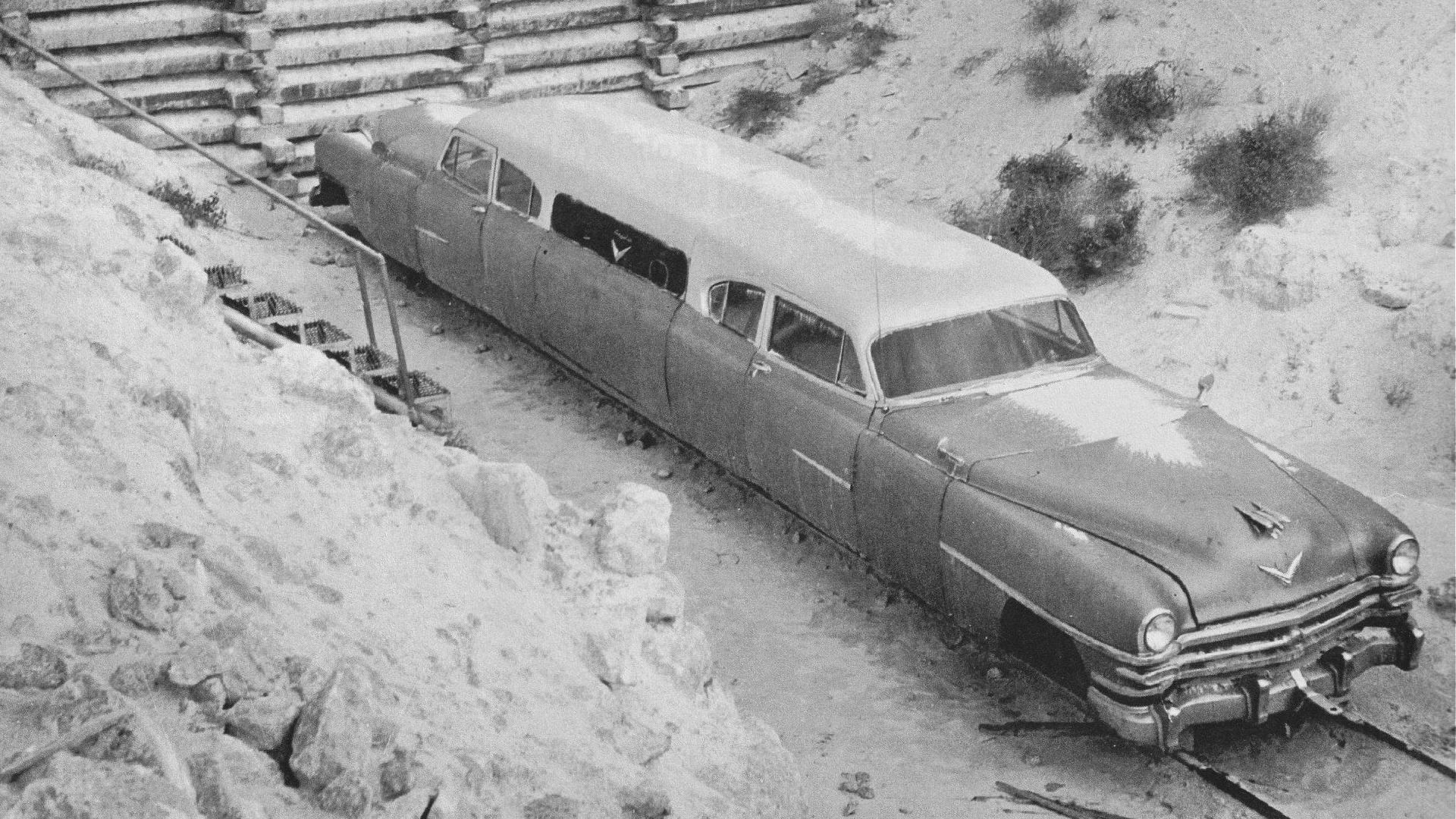

The picture speaks for itself: What on god’s green earth is that? It’s like someone made CatDog out of a couple 1950s sedans, and then stretched it out for laughs. Such a strange contraption could only have an equally odd origin, and the “Blue Goose” as it’s known does indeed. It also has a mysterious fate, but one thing’s for sure: It was just a little too fast.
The Blue Goose was built in Plaster City, California near the middle of its southern border by a company called U.S. Gypsum. Its title is self-explanatory; it mined and processed gypsum, the stuff drywall is made of. As you’d expect of a large-scale quarrying and manufacturing business, it had its own dedicated railway, and that’s the sky the Blue Goose was meant to fly.

The narrow-gauge line (with rails closer together than usual) connected USG’s Plaster City processing plant to a quarry in the Fish Mountains some 25 miles away. This comes via a comment on Just A Car Guy from Steve Bogdan, former curator of the Imperial Valley Transportation Museum, and one of the best sources for info on the Blue Goose.
In addition to the gypsum, Bogdan said, USG had to ship quarry crews to and from the site, in something that’d shelter them from the desert heat and sandstorms. Because narrow-gauge lines aren’t widely used though, there probably wasn’t any off-the-shelf equipment that’d do the job. So, USG took matters into its own hands.
At some point in the mid-1950s according to a Reddit post, USG got a hold of two 1953 Chrysler New Yorker Club Coupes and joined them at their rears, extending their bodies for additional space. The resulting behemoth came in at 38 feet long, 6,000 pounds empty, and had controls at both ends so it wouldn’t need to turn around. The Blue Goose could achieve a top speed of 40 mph using a single, centrally mounted 160-horsepower engine whose origin has been lost to time. It might’ve been the then-new 331 cubic-inch (5.4-liter) Hemi V8, though that made a greater 180 horsepower according to Over Drive Magazine. We just don’t know.
As for the Blue Goose name, we don’t know for sure where that came from either. Apocryphally, it was inspired by the similar narrow-gauge, automobile-based Galloping Goose railcars—dirt-cheap substitutes for trains that kept the Denver & Rio Grande Western alive through the Great Depression.
Not much about its service life survives either, though the Blue Goose is suggested to have flown its last flight by 1970. There are a couple reasons for this: One source says it was just too worn out to be useful, while another gives a more exciting reason.
“My brother and I rode in the Blue Goose many times—our dad, Don Haskell, was the Quarry Superintendent for U.S. Gypsum back when it was built,” reads a comment from one Carol Haskell on a USG Facebook post. “It was really fast and hard to keep on the narrow-gauge rails so the company decided it could be dangerous. People came from all over to see it and our dad was very proud of his project.”

What happened from there is most mysterious of all, because various sources assert one of two wildly differing fates: Either it was scrapped, or it exists today in private preservation. The scrapping story is given the most detail in the Reddit post above, which says that unspecified “records” indicate the vehicle was to be donated in 1970 to the Pacific Southwest Railway Museum Association. Supposedly, the Blue Goose was destroyed before this could happen.
“I was told that it was donated to a railroad group in California years ago, but wasn’t able to find it so I believe it was scrapped,” said Carol Haskell.
However, a happier ending seems more likely. Instead of meeting the crusher, the museum curator cited above said in 2010 that the Blue Goose was “acquired by the owner of the trucking company that hauled the finished sheetrock from the mill. About 12 years ago the vehicle was donated back to the company.”

If the Blue Goose has gone to roost, there’s no obvious sign of it in Google’s satellite photos of Plaster City, or in photos taken from the road along the plant. USG also didn’t respond to our inquiry by time of publication.
Whether the Blue Goose still exists isn’t that important though, as it’s clearly not accessible to the general public even if it’s still around. It’s even less likely that it’d still run and could still carry passengers. But the fact that it’s captivating us more than half a century since it last served anyone is proof its existence was worthwhile, because it’s still bringing wonder into our lives today—much like the turkeys we’re all diving into this week. Happy Thanksgiving, everyone.
Got a tip or question for the author? You can reach them here: james@thedrive.com